1993 CHEVROLET CAMARO maintenance schedule
[x] Cancel search: maintenance schedulePage 293 of 358
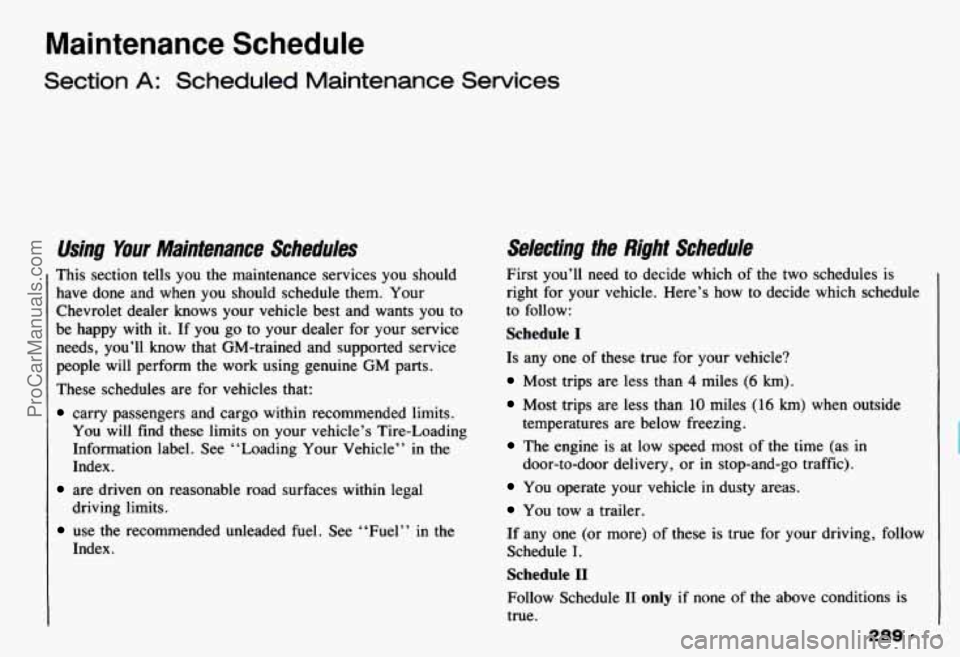
Maintenance Schedule
Section A: Scheduled Maintenance Services
Using Your Maintenance Schedules
This section tells you the maintenance services you should have done and when you should schedule them. Your
Chevrolet dealer knows your vehicle best and wants you to
be happy
with it. If you go to your dealer for your service
needs, you’ll know that GM-trained and supported service people will perform the work using genuine
GM parts.
These schedules are for vehicles that:
carry passengers and cargo within recommended limits.
You will find these limits on your vehicle’s Tire-Loading
Information label. See “Loading Your Vehicle” in the
Index.
are driven on reasonable road surfaces within legal
use the recommended unleaded fuel. See “Fuel” in the
driving limits.
Index.
Se/ecting the Right Schedule
First you’ll need to decide which of the two schedules is
right for your vehicle. Here’s how to decide which schedule
to follow:
Schedule I
Is any one of these true for your vehicle?
Most trips are less than 4 miles (6 km).
Most trips are less than 10 miles (16 km) when outside
temperatures are below freezing.
The engine is at low speed most of the time (as in
door-to-door delivery, or
in stop-and-go traffic).
You operate your vehicle in dusty areas.
You tow a trailer.
If any one (or more) of these is true for your driving, follow
Schedule I.
Schedule I1
Follow Schedule II only if none of the above conditions is
true.
289 9 .
ProCarManuals.com
Page 294 of 358

Maintenance Schedule
Section A: Scheduled Maintenance Services (Cont.)
Schedule I
Follow Schedule I if your vehicle is
MAINLY driven under one or more of
the following conditions:
When most trips are less than 4 miles
When most trips are less than 10 miles
(6 km).
(16 km) and outside temperatures
remain below freezing.
When most trips include extended
idling and/or frequent low-speed
operation, as in stop-and-go traffic.
When towing a trailer.
When operating in dusty areas.
Schedule I should also be followed if
the vehicle is used for delivery service, police, taxi or other commercial
applications.
*An Emission Control Service.
ft The U. S. Environmental Protection Agency
has determined that the failure to perform
this maintenance item will not nullify the
emission warranty or limit recall liability
prior to the completion
of vehicle usehl
life. General Motors, however, urges that
all recommended maintenance services be
performed at the indicated intervals and
the maintenance be recorded in “Section
E:
Maintenance Record. ”
9 290
ITEM
NO.
2
4
6
8
10 -
WHAT TO SERVICE
See “Explanation of Scheduled Maintenance
Services” following Schedules
I and II.
WHEN TO PERFORM
Miles (kilometers) or Months
(whichever occurs first).
Chassis Lubrication I Every other oil change. ~~
I
Transmission Service I
See “Explanation of Scheduled Maintenance
Services” following Schedules
I and II. I
Spark Plugwire Inspection** 1
Every 30,000 Miles (50 OOO km).
Fuel Tank, Cap & Lines Inspection** I
ProCarManuals.com
Page 296 of 358
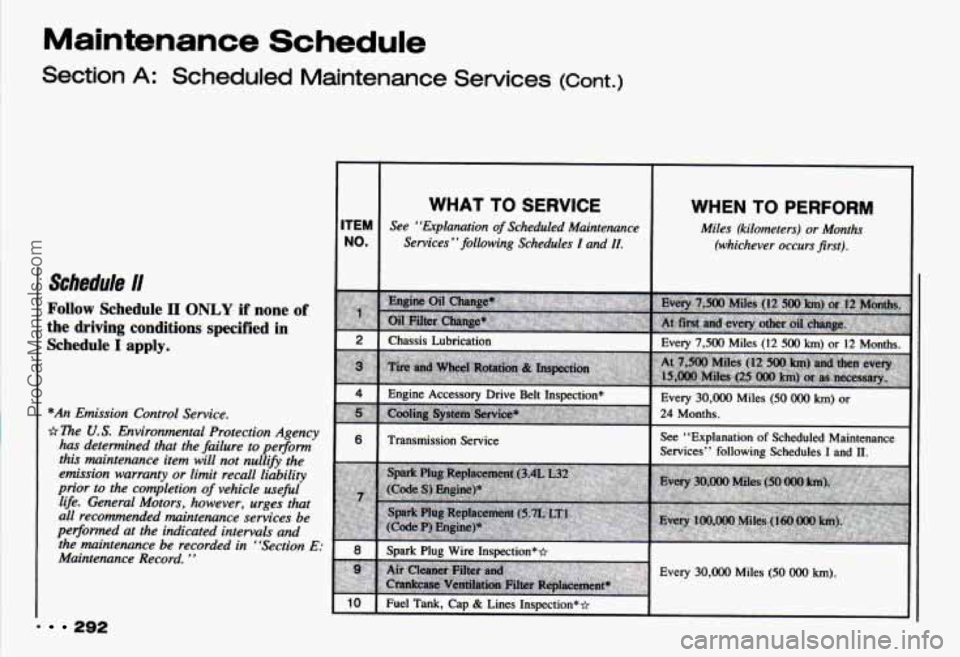
Maintenance Schedule
Section A: Scheduled Maintenance Services (Cont.)
Schedule I1
Follow Schedule II ONLY if none of
the driving conditions specified in
Schedule I apply.
*An Emission Control Service.
r?r ne U. S. Environmental Protection Agency
has determined that the failure
to per$orm
this maintenance item will not nullify the
emission warranty or limit recall liability
prior
to the completion of vehicle usejid
life. General Motors, however, urges that
all recommended maintenance services be
per$omd at the indicated intervals and
the maintenance be recorded in “Section E:
Maintenance Record. ’’
292
ITEM
NO.
2
4
6
a
10
WHAT TO SERVICE
See “Explanation of Scheduled Maintenance
Services” following Schedules
I and II.
WHEN TO PERFORM
Miles (kilometers) or Months (whichever occurs first).
Transmission Service
I
See “Explanation of Scheduled Maintenance
Services” following Schedules
I and II.
ProCarManuals.com
Page 298 of 358
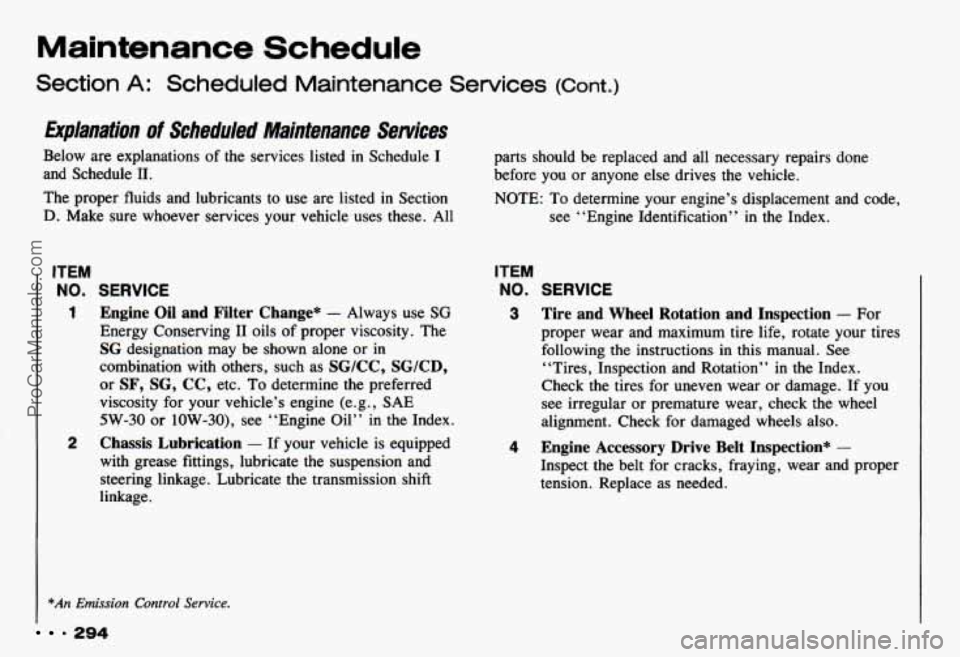
Maintenance Schedule
Section A: Scheduled Maintenance Services (Cont.)
Eirplanation of Scheduled Maintenance Semices
Below are explanations of the services listed in Schedule I
and Schedule 11.
The proper fluids and lubricants
to use are listed in Section
D. Make sure whoever services your vehicle uses these. All
ITEM
NO. SERVICE
1 Engine Oil and Filter Change* - Always use SG
Energy Conserving I1 oils of proper viscosity. The
SG designation may be shown alone or in
combination with others, such as
SGKC, SG/CD,
or SF, SG, CC, etc. To determine the preferred
viscosity for your vehicle’s engine (e.g., SAE
5W-30 or 10W-30), see “Engine Oil” in the Index.
2 Chassis Lubrication - If your vehicle is equipped
with grease fittings, lubricate the suspension and
steering linkage. Lubricate the transmission shift
linkage. parts should be replaced and all necessary repairs done
before
you or anyone else drives the vehicle.
NOTE: To determine your engine’s displacement and code, see ‘‘Engine Identification” in the Index.
ITEM
NO. SERVICE
3 Tire and Wheel Rotation and Inspection - For
proper wear and maximum tire life, rotate your tires
following the instructions in this manual. See “Tires, Inspection and Rotation’’
in the Index.
Check the tires for uneven wear or damage. If
you
see irregular or premature wear, check the wheel
alignment. Check for damaged wheels also.
Inspect the belt for cracks, fraying, wear and proper
tension. Replace
as needed.
4 Engine Accessory Drive Belt Inspection* -
I
*An Emission Control Service.
9 294
ProCarManuals.com
Page 300 of 358
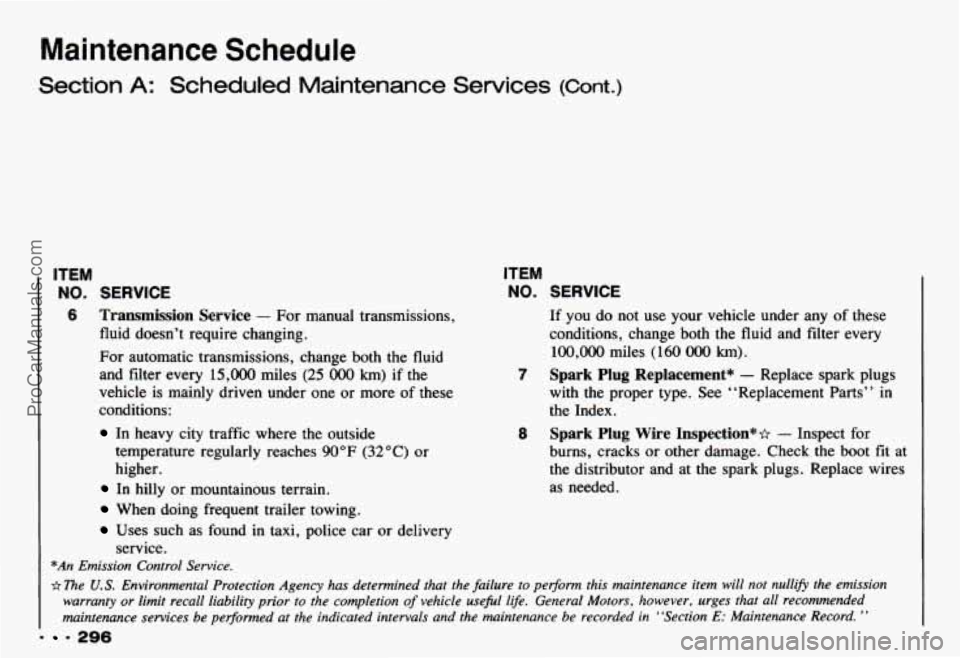
Maintenance Schedule
aection A: Scheduled Maintenance Services (Cont.)
ITEM
NO. SERVICE
6 Transmission Service - For manual transmissions,
fluid doesn’t require changing.
For automatic transmissions, change both the fluid
and filter every
15,000 miles (25 OOO km) if the
vehicle is mainly driven under one
or more of these
conditions:
ITEM
NO. SERVICE
If you do not use your vehicle under any of these
conditions, change both the fluid and filter every
100,OOO miles (160 O00 km).
7 Spark Plug Replacement* - Replace spark plugs
with the proper type. See “Replacement Parts” in
the Index.
burns, cracks or other damage. Check
the boot fit at
the distributor and at
the spark plugs. Replace wires
as needed.
8 Spark Plug Wire Inspection** - Inspect for In heavy city traffic where the outside
temperature regularly reaches
90°F (32°C) or
higher.
In hilly or mountainous terrain.
When doing frequent trailer towing.
Uses such as found in taxi, police car or delivery
service.
*An Emission Control Service.
The
U. 5’. Environmental Protection Agency has determined that the failure to perform this maintenance item will not nullify the emission
warranty or limit recall liability prior to the completion
of vehicle useful life. General Motors, however, urges that all recommended
maintenance services be performed at the indicated intervals and the maintenance be recorded in “Section
E: Maintenance Record. ”
= 296
ProCarManuals.com
Page 302 of 358
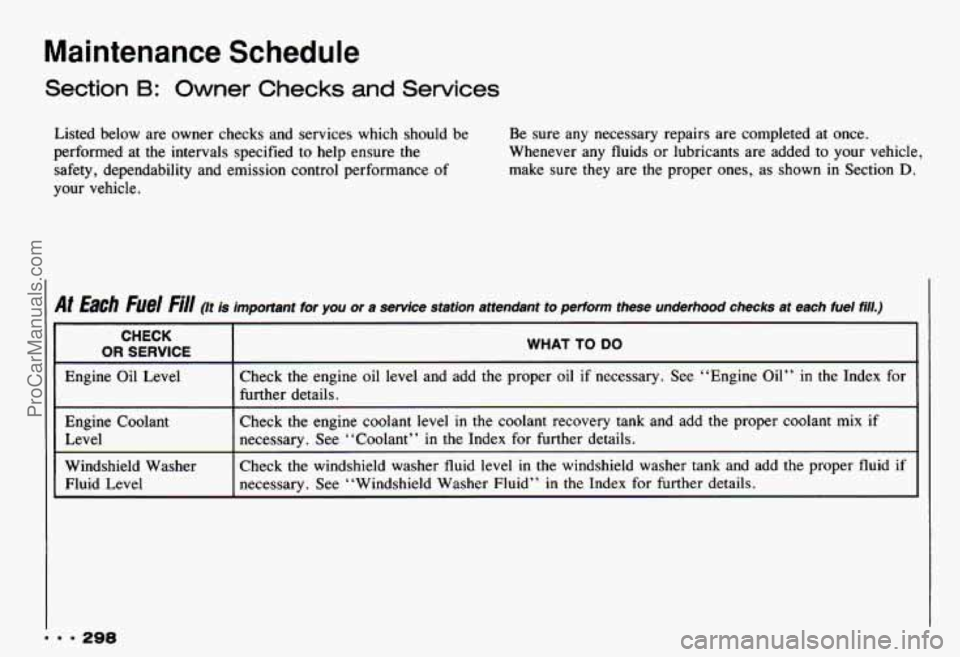
Maintenance Schedule
Section B: Owner Checks and Services
Listed below are owner checks and services which should be
performed at the intervals specified to help ensure the
safety, dependability and emission control performance
of
your vehicle. Be
sure any necessary repairs are completed at once.
Whenever any fluids or lubricants are added to your vehicle,
make sure they are the proper ones, as shown in Section
D.
At Each Fuel Fill (/t is important for you or a service station 8ttend8nt to perform these underhood checks a\
t each fuel fili.)
CHECK
OR SERVICE WHAT TO DO
J
Engine Oil Level
necessary. See “Windshield Washer Fluid”
in the Index for further details.
Fluid Level Check the
windshield washer fluid level
in the windshield washer tank and add the proper fluid if Windshield Washer necessary. See “Coolant”
in the Index
for further details.
Level Check
the engine coolant
level in the coolant recovery tank and add the proper coolant mix if
Engine Coolant Check the engine
oil level and add the proper oil if necessary. See “Engine Oil”
in the Index for
further details.
ProCarManuals.com
Page 304 of 358
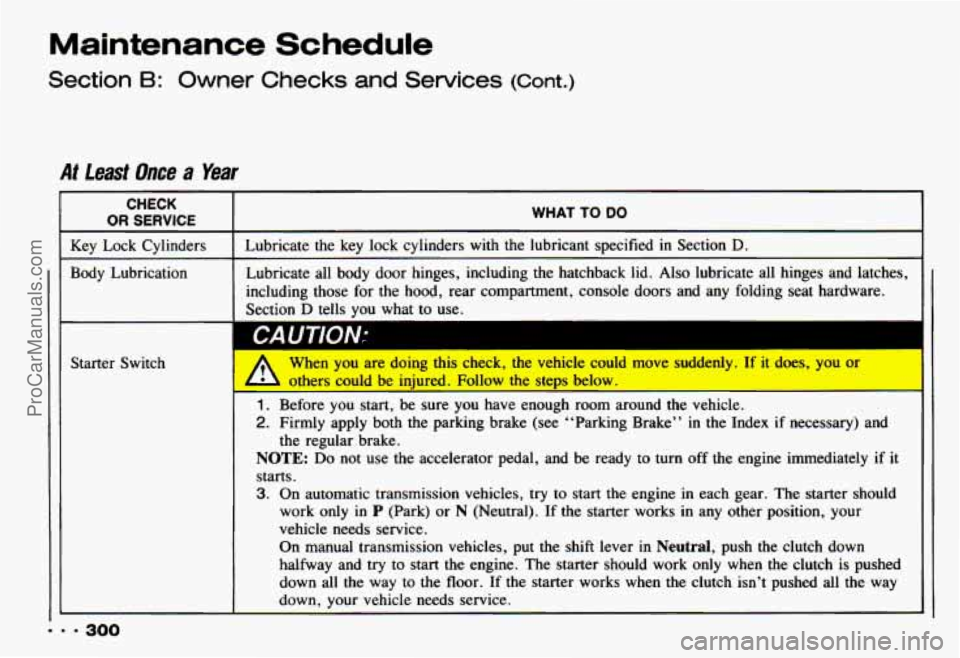
Maintenance Schedule
Section B: Owner Checks and Services (Cont.)
At lead Once a Year
CHECK
OR SERVICE WHAT TO DO
Lubricate the key lock cylinders with the lubricant specified in Section D.
Lubricate all body door hinges, including the hatchback lid. Al\
so lubricate all hinges and latches,
including those for the hood, rear compartment, console doors a\
nd
any folding seat hardware.
Section
D tells you what to use.
’.
1. Before you start, be sure you have enough room around tne vehicle.
2. Firmly apply both the parking brake (see “Parking Brake” \
in the Index if necessary) and
NOTE: Do not use the accelerator pedal, and be ready to turn off the engin\
e immediately if it
starts.
3. On automatic transmission vehicles, try to start the engine in each gear. The starter should
the regular brake.
work
only in P (Park) or N (Neutral). If the starter works in any other position, your
vehicle needs service.
On manual transmission vehicles, put the shift lever
in Neutral, push the clutch down
halfway and try to start
the engine. The starter should work only when the clutch is pushed
down all
the way to the floor. If the starter works when the clutch isn’t pushed all the way
down. your vehicle needs service.
... 300
ProCarManuals.com
Page 307 of 358
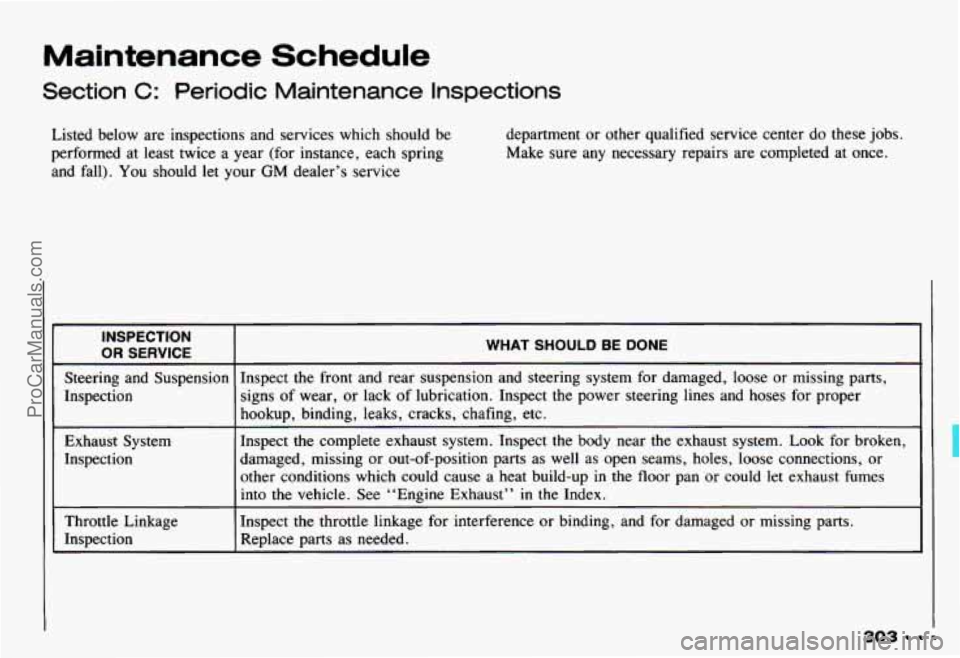
Maintenance Schedule
Section C: Periodic Maintenance Inspections
Listed below are inspections and services which should be
performed at least twice a year (for instance, each spring
and fall). You should let your
GM dealer’s service department
or other qualified service center do these jobs.
Make sure any necessary repairs are completed at once.
INSPECTION
OR SERVICE I WHAT SHOULD BE DONE
Steering and Suspension Inspect the front and rear suspension and steering system for damaged, loose or missing parts,
Inspection signs
of wear, or lack of lubrication. Inspect the power steering lines and hoses for proper
hookup, binding, leaks, cracks, chafing, etc.
Exhaust System
Inspection Inspect the complete exhaust
system. Inspect the body near the exhaust system.
Look for broken,
damaged, missing or out-of-position parts as well as open seams, holes, loose connections, or
other conditions which could cause a heat build-up in the floor pan or could ].et exhaust fumes
into the vehicle. See “Engine Exhaust’’
in the Index.
Throttle Linkage Inspect the throttle linkage for interference or binding, and for damaged or missing parts.
Inspection Replace parts as needed.
I 303
ProCarManuals.com